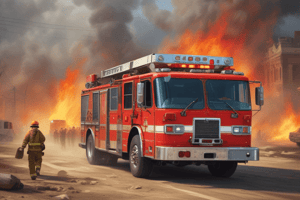Podcast
Questions and Answers
What is the primary goal of fire suppression operations?
What is the primary goal of fire suppression operations?
- To train firefighters for emergency situations
- To save property from fire damage
- To control and extinguish fires effectively (correct)
- To ensure firefighter safety at all costs
When establishing command at an emergency incident, what is the preferred method for transferring command?
When establishing command at an emergency incident, what is the preferred method for transferring command?
- Radio transfer only
- Written transfer of command
- Radio transfer followed by face-to-face (correct)
- Face-to-face transfer only
What is one of the responsibilities of the incident commander (IC) at an emergency incident?
What is one of the responsibilities of the incident commander (IC) at an emergency incident?
- Delegating all responsibilities to subordinates
- Assuming command and taking an effective fixed physical command position (correct)
- Creating a detailed budget for future operations
- Performing firefighting duties directly
What important assessment should the IC ensure is performed on the structure?
What important assessment should the IC ensure is performed on the structure?
What should be included in the development of the Incident Action Plan (IAP)?
What should be included in the development of the Incident Action Plan (IAP)?
What should officers rely on to make tactical and strategic decisions?
What should officers rely on to make tactical and strategic decisions?
What is the primary responsibility of the Incident Safety Officer?
What is the primary responsibility of the Incident Safety Officer?
Under what circumstances is a Two-out or Rapid Intervention Team (RIT) established?
Under what circumstances is a Two-out or Rapid Intervention Team (RIT) established?
Who is responsible for assigning a qualified Incident Safety Officer at significant incidents?
Who is responsible for assigning a qualified Incident Safety Officer at significant incidents?
Officers should be mindful of their responsibilities primarily for the safety of whom?
Officers should be mindful of their responsibilities primarily for the safety of whom?
What does the IC evaluate when determining the safety of operations?
What does the IC evaluate when determining the safety of operations?
What should be limited to situations with a high potential to save endangered human lives?
What should be limited to situations with a high potential to save endangered human lives?
Which principle states that no known risk to safety is acceptable without a possibility of saving lives or property?
Which principle states that no known risk to safety is acceptable without a possibility of saving lives or property?
Which action is NOT part of developing an effective ICS organization?
Which action is NOT part of developing an effective ICS organization?
What should Company Officers and Incident Commanders evaluate regarding their actions?
What should Company Officers and Incident Commanders evaluate regarding their actions?
What is the correct response when human life may be endangered?
What is the correct response when human life may be endangered?
Which of the following activities is recognized as an inherent risk to member safety?
Which of the following activities is recognized as an inherent risk to member safety?
Which principle advises to 'risk a lot to save a lot'?
Which principle advises to 'risk a lot to save a lot'?
Which action should be taken regarding commands during an incident?
Which action should be taken regarding commands during an incident?
Flashcards are hidden until you start studying
Study Notes
Fire Suppression Operations Goals
- Save lives and reduce suffering for individuals endangered by fire, including firefighters.
- Control and extinguish fires swiftly and effectively to minimize property damage.
- Ensure the safety of firefighters is the priority during operations.
Incident Command (IC) Responsibilities
- Confirm command and establish a fixed command position, declaring mode/strategy.
- Prefer radio over face-to-face communication for transferring command to avoid hindering operations.
- Conduct a comprehensive 360° size-up of the structure, assessing all hazards including basements.
- Develop a complete Incident Action Plan (IAP) and overall strategy.
- Request additional resources as necessary for effective response.
Risk Management Principles
- Evaluate the situation, incorporating risk assessments and operational safety into decision-making.
- Maintain clear and immediate incident communications throughout operations.
- Assign units to execute strategies and attack plans effectively.
- Create an efficient Incident Command System (ICS) organization, ensuring personnel accountability and direct oversight.
- Regularly review and adjust operational plans, clearly communicate any deviations.
- Evaluate risks to members, particularly relating to potential danger to human lives.
Calculated Risk Operations
- High Risk Situations: Activities presenting significant danger to personnel should only be conducted when there's a high potential to save lives (Risk a lot to save a lot).
- Property and Environment Protection: Risks associated with protecting property should be acknowledged, and actions should prioritize member safety (Risk a little to save a little).
- No Acceptable Risk: No risk is acceptable if there is no potential to save lives or property (Risk nothing to save nothing).
Safety Responsibilities
- Officers hold responsibilities for the safety of their subordinates; focus on maintaining safety culture.
- Assign a qualified Incident Safety Officer at significant incidents to assess hazards and provide safety oversight.
- Establish a Two-out or Rapid Intervention Team (RIT) when one or more crews operate within hazardous zones.
Studying That Suits You
Use AI to generate personalized quizzes and flashcards to suit your learning preferences.




